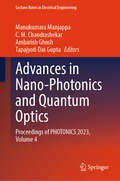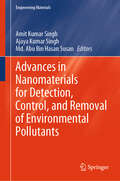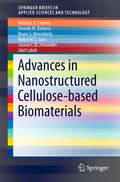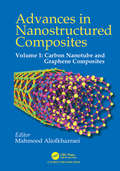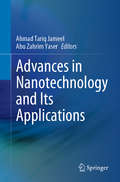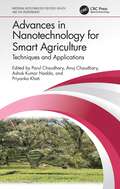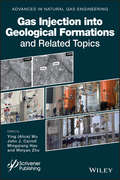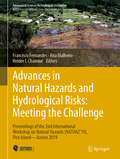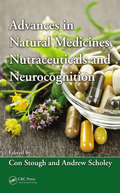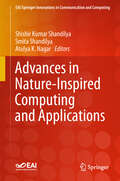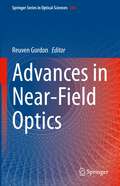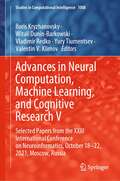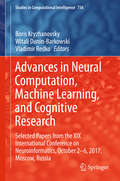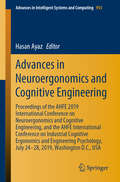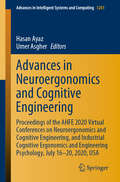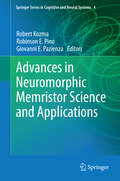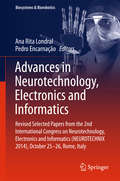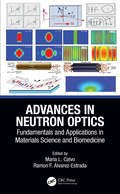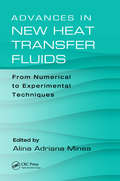- Table View
- List View
Advances in Nano-Photonics and Quantum Optics: Proceedings of PHOTONICS 2023, Volume 4 (Lecture Notes in Electrical Engineering #1245)
by Tapajyoti Das Gupta Manukumara Manjappa C. M. Chandrashekar Ambarish GhoshThis book presents the proceedings of the Biennial Photonics Conference (Photonics 2023) held at IISc, Bengaluru on 5-8 July 2023. It covers topics across multiple areas of photonics, including established areas like optical communication and networks, quantum optics, non-linear and ultrafast photonics, nanophotonics, biophotonics and bioimaging, photonic integrated circuits, fibers and sensors, optical materials and fabrication techniques, optical metrology, and instrumentation, optofluidics, laser applications, optoelectronics. The book also covers emerging areas in photonics, such as THz photonics, structured Light, 2D materials, optomechanics, topological photonics, and AI/ML in photonics. The book will be useful for researchers and professionals interested in the broad field of photonics.
Advances in Nanomaterials for Detection, Control, and Removal of Environmental Pollutants (Engineering Materials)
by Amit Kumar Singh Ajaya Kumar Singh Md. Abu Bin Hasan SusanThis book presents a comprehensive exploration of the latest research in nanomaterial development for environmental pollution control. It delves into various themes, including the utilization of nanosensors in environmental monitoring, the creation of nano adsorbents and nanocatalysts for pollutant removal and degradation, and the potential application of nanomaterials and nanotechnology in remediating contaminated sites. The book also addresses potential risks associated with using nanomaterials in environmental pollution control, discussing nanotoxicology and the potential environmental and health impacts of nanomaterials. Furthermore, it explores the existing regulatory framework for nanomaterial usage in environmental pollution control and outlines future directions for developing and implementing nanomaterials in this domain. Featuring collected contributions from an international cross-section of active researchers in this broad and interdisciplinary field, this book caters to scientists, researchers, students, and professionals in environmental science, chemistry, materials science, and nanotechnology. It provides a detailed overview of recent advancements in nanomaterial development and application for environmental pollution control, emphasizing how nanotechnology holds promise for delivering effective solutions to environmental challenges.
Advances in Nanomaterials-based Cell Biology Research
by Yunfeng Lin Ronghui ZhouThis book aims to comprehensively summarize the current research status of nanomaterials and cell biology. It highlights the biological effects and biomedical applications of nanomaterials for specific diseases, bone tissue engineering, and skeletal muscle regeneration. It also provides the details of the biomedical applications of nucleic acid nanomaterials in drug delivery carriers, antimicrobial therapy, vaccine, and neurodegenerative diseases. Therefore, this book renders the audience a better understanding of nanomaterials along with the diverse applications in the cell biology field from recent works to perspectives.
Advances in Nanostructured Cellulose-based Biomaterials (SpringerBriefs in Applied Sciences and Technology)
by Neftali L. V. Carreño Ananda M. Barbosa Bruno S. Noremberg Mabel M. S. Salas Susana C. M. Fernandes Jalel LabidiThis book provides an overview of the advances on nanostructured celullose from different obtaining forms: natural plants and bacterial microorganisms. It gives the reader an introduction of cellulose focusing in nanosize particles, its potential applications and future perspectives. The potential use of cellulose in the biomedical field is highlighted.
Advances in Nanostructured Composites: Volume 1: Carbon Nanotube and Graphene Composites
by Mahmood AliofkhazraeiComposites and nanocomposites are used in cases where long durability and strength of components are required; i.e., where high stress levels, erosion processes and multiphase environments are present, including the parts under collision and impact, the parts under rotating motion and erosion (like excavation drills in oil and gas wells). The first volume of this book aims to provide a guide for fabrication of new nanocomposites mainly based on carbon nanotubes and graphene. The main topics of this volume are: Application of Nano-powders for Formation of Metal Matrix of Composites, Conjugated Polymer Nanocomposites, Biopolymer Nanocomposites, Dental Nanocomposites, Graphene-based Nanocomposites for Electrochemical Energy Storage, Polymer/Filler Composites for Optical Diffuse Reflectors, Synthesis and Applications of LDH-Based Nanocomposites, Rubber—CNT Nanocomposites, Nanocomposite Fibers with Carbon Nanotubes, Fabrications of Graphene Based Nanocomposites for Electrochemical Sensing of Drug Molecules, Recent Advances in Graphene Metal Oxide Based Nanocomposites.
Advances in Nanostructured Composites: Volume 2: Applications of Nanocomposites
by Mahmood AliofkhazraeiThe first volume of this book covered Section I: Introduction to Nanocomposites Fabrication and Section II: CNT and Graphene Nanocomposites. The present second volume covers Section III: Recent Applications of Nanocomposites. The second volume aims to provide a guide for different applications of modern nanocomposites especially those fabricated by carbon nanotubes and graphene. The book makes a comparative study of fiber-reinforced composites which have been embedded into the matrix with nanocomposites containing nanotubes in place of fibers. The main topics of this volume are: Electrochemical Properties of Nanoporous Based Materials, Fabrication and Application of Graphene Oxide-based Metal and Metal Oxide Nanocomposites, Electrochemical Sensors/Biosensors Based on Carbon Aerogels/Xerogels, Advances in Nanobiocatalysis: Strategies for Lipase Immobilization and Stabilization, Metal Oxide Based Heterojunction Nanoscale Materials for Chemiresistive Gas Sensors, Recent Advances in Polymer Nanocomposite Coatings for Corrosion Protection, Recent Advances in the Design of Nanocomposite Materials via Laser Techniques for Biomedical Applications, Carbonaceous Nanostructured Composites for Electrochemical Power Sources: Fuel Cells, Supercapacitors and Batteries, Bismuth Vanadate Based Nanostructured and Nanocomposite Photocatalyst Materials for Water Splitting Application.
Advances in Nanotechnology and Its Applications (Springerbriefs In Applied Sciences And Technology Ser.)
by Abu Zahrim Yaser Ahmad Tariq JameelThis book highlights current trends and research advances in nanotechnology and its applications. It discusses the synthesis and characterization of nanomaterials / nanocomposites for novel applications in environmental monitoring and sustainability, and presents new findings on wastewater treatment technologies using nanofiltration membranes.
Advances in Nanotechnology for Smart Agriculture: Techniques and Applications (Microbial Biotechnology for Food, Health, and the Environment)
by Parul ChaudharyThe yield of major agricultural crops can be severely decreased due to the inappropriate application of commonly used harmful chemicals. Excessive agrochemicals in field application can negatively affect microbial populations and their diversity, which in turn ultimately affects plant growth. Thus, it is necessary to turn toward more eco-friendly approaches which equally protect crops as well as the desirable microbial populations of complex soil systems. Nanoparticles are considered as potential agents for the production and development of sustainable agriculture. Green synthesis of nanoparticles has gained attention as a useful measure to diminish the harmful effects associated with the old methods of nanoparticle synthesis. Advances in Nanotechnology for Smart Agriculture: Techniques and Applications illustrates the science and practical applications of nanoparticles for sustainable agriculture. Features: Examines the role of nanotechnology in agricultural best practices, including sustainable development, precision farming, and long-term soil health
Advances in Natural Gas Engineering
by John J. Carroll Weiyao Zhu Alice Wu Mingqiang HaoThis is the eighth volume in the series, Advances in Natural Gas Engineering, focusing on gas injection into geological formations and other related topics, very important areas of natural gas engineering. This volume includes information for both upstream and downstream operations, including chapters detailing the most cutting-edge techniques in acid gas injection, carbon capture, chemical and thermodynamic models, and much more. Written by some of the most well-known and respected chemical and process engineers working with natural gas today, the chapters in this important volume represent the most state-of-the-art processes and operations being used in the field. Not available anywhere else, this volume is a must-have for any chemical engineer, chemist, or process engineer in the industry. Advances in Natural Gas Engineering is an ongoing series of books meant to form the basis for the working library of any engineer working in natural gas today.
Advances in Natural Hazards and Hydrological Risks: Proceedings of the 2nd International Workshop on Natural Hazards (NATHAZ'19), Pico Island—Azores 2019 (Advances in Science, Technology & Innovation)
by Helder I. Chaminé Francisco Fernandes Ana MalheiroThis book gathers the proceedings of the 2nd International Workshop on Natural Hazards (NATHAZ'19), held in Lajes do Pico, Pico Island, Azores in 2019. Natural hazards constitute the threat of a naturally occurring event having a negative effect on human beings. These effects are often called natural disasters. Among the natural hazards and potential disasters to be considered are: earthquakes, volcanic eruptions, landslides, subsidence, floods, droughts and coastal erosion. In addition, there are anthropogenic hazards that occur as a result of human interactions with the environment. They include technological hazards, which occur due to exposure to hazardous substances in the environment. Grasping the behaviour of natural systems requires a comprehensive understanding of climatology, geology and hydrology data and dynamics. Thus, it is important to conduct hazard and risk assessment studies for meaningful hazard mitigation. Further, the book demonstrates that an accurate understanding of natural systems and interactions between engineering and natural resources is of vital significance to the entire socio-economic sector. This volume offers an overview of natural hazards in model regions in Europe, America, and Atlantic islands. Providing new insights on the characterisation, assessment, protection and modelling of geological hazards, water systems, urban areas and coastal zones, it represents a valuable resource for all researchers and practitioners in the fields of Geosciences, Hydrology, Water Resources, Natural Hazards, Environments and Engineering. Main topics include:1. Natural Hazards and Disasters2. Sustainable Water Systems and Climate Change3. Technological Hazards and Engineering Design
Advances in Natural Hazards and Volcanic Risks: Proceedings of the 3rd International Workshop on Natural Hazards (NATHAZ’22), Terceira Island—Azores 2022 (Advances in Science, Technology & Innovation)
by Helder I. Chaminé Francisco Fernandes Ana MalheiroThis book comprises the selected proceedings of the 3rd International Workshop on Natural Hazards (NATHAZ’22), Angra do Heroísmo, Terceira Island, Azores, 2022. The book interests all researchers and practitioners in Earth Sciences, Volcanic Risks, Natural Hazards, Geoethics, Environmental Sciences and Engineering. Terceira is a volcanic island with volcanic systems with caldera (Cinco Picos, Guilherme Moniz, Santa Bárbara and Pico Alto central volcanoes) and an active fissural zone defined by various alignments of small volcanic cones, lava domes and fault zones. The agricultural landscape, the natural and forest reserve, as well as the natural pools make the island a unique place to visit. The historic downtown of Angra do Heroísmo is a UNESCO world heritage, and several iconic buildings witness the island’s geodynamic history. Natural hazards result from a threat of a naturally occurring event that will have a negative effect on humans. That damaging effect is often called natural disasters. Among the natural hazards and potential disasters to be considered are: earthquakes, volcanic eruptions, landslides, subsidence, floods, droughts and coastal erosion. In addition, anthropogenic hazards occur as a result of human interaction with the environment. They comprise technological risks due to exposure to hazardous substances in the environment. Natural systems in different frameworks require a comprehensive understanding of climatology, geology, hydrology and volcanic data, processes and dynamics. Thus, it is important to perform hazard and risk assessment studies to accomplish hazard mitigation. In addition, it highlighted the role of variability and climate change in Earth systems. Furthermore, an accurate understanding of the natural systems and interactions with engineering, geodiversity and natural resources is vital to the entire socioeconomic sector. This book is expected to offer an overview of natural hazards in model regions in Europe, America, Asia and the Atlantic islands. It gives new insights into the characterization, assessment, protection, and modelling of geological hazards, volcanic systems, urban areas, coastal zones and engineering approaches by international researchers and professionals. The scientific committee comprises lead geoscientists, natural hazards related practitioners, and academics worldwide. The main topics include: 1. Multi-hazards and risks: sustainable society, disasters and geoethics 2. Natural hazards and assessment: rock falls, landslides, urban planning and management 3. Sustainable Earth systems: hazards and climate change 4. Terceira Island geology and geodiversity: meeting volcanological hazards in the Azores
Advances in Natural Medicines, Nutraceuticals and Neurocognition
by Con Stough Andrew ScholeyGreat strides have been made in the field of natural medicine with respect to neurocognition. Once limited to the province of niche publications, these discoveries are now routinely explored in mainstream psychopharmacology, neuroscience, nutrition, and medical journals. Now presented in one convenient volume, Advances in Natural Medicines, Nutrace
Advances in Nature of Science Research: Concepts and Methodologies
by Myint Swe KhineThis book consolidates contemporary thinking and research efforts in teaching and learning about the nature of science in science education. The term 'Nature of Science' (NoS) has appeared in the science education literature for many decades. While there is still a controversy among science educators about what constitutes NoS, educators are unanimous in acknowledging the importance of this topic as well as the need to make it explicit in teaching science. The general consensus is that the nature of science is an intricate and multifaceted theme that requires continued scholarship. Recent analysis of research trends in science education indicates that investigation of the nature of science continues to be one of the most prevalent topics in academic publications. Advances in Nature of Science Research explores teaching and assessing the nature of science as a means of addressing and solving problems in conceptual change, developing positive attitudes toward science, promoting thinking habits, advancing inquiry skills and preparing citizens literate in science and technology. The book brings together prominent scholars in the field to share their cutting-edge knowledge about the place of the nature of science in science teaching and learning contexts. The chapters explore theoretical frameworks, new directions and changing practices from intervention studies, discourse analyses, classroom-based investigations, anthropological observations, and design-based research.
Advances in Nature-Inspired Computing and Applications (EAI/Springer Innovations in Communication and Computing)
by Atulya K. Nagar Shishir Kumar Shandilya Smita ShandilyaThis book contains research contributions from leading global scholars in nature-inspired computing. It includes comprehensive coverage of each respective topic, while also highlighting recent and future trends. The contributions provides readers with a snapshot of the state of the art in the field of nature-inspired computing and its application. This book has focus on the current researches while highlighting the empirical results along with theoretical concepts to provide a comprehensive reference for students, researchers, scholars, professionals and practitioners in the field of Advanced Artificial Intelligence, Nature-Inspired Algorithms and Soft Computing.
Advances in Near-Field Optics (Springer Series in Optical Sciences #244)
by Reuven GordonThis book brings together tutorial-style expository chapters on both foundational material and current research areas in near-field optics. The starting point for the book was the Summer School at the 16th International Conference on Near-Field Optics, Nanophotonics and Related Techniques (2022), with each Summer School short course represented by a chapter, along with an additional specially selected chapter on a complementary topic. Together, the chapters within present a modern perspective of the area of near-field optics, focusing on recent theoretical approaches, but also capturing the evolution of the field. Each chapter is written by an internationally-recognized expert and provides a tutorial on a different aspects of the theory and analytical methods for near-field optics, nanophotonics, and plasmonics. While the material will be accessible at the graduate level, it will also provide a useful reference for established researchers in near-field optics and scientists in nearby fields.
Advances in Neural Computation, Machine Learning, and Cognitive Research IV: Selected Papers from the XXII International Conference on Neuroinformatics, October 12-16, 2020, Moscow, Russia (Studies in Computational Intelligence #925)
by Boris Kryzhanovsky Witali Dunin-Barkowski Vladimir Redko Yury TiumentsevThis book describes new theories and applications of artificial neural networks, with a special focus on answering questions in neuroscience, biology and biophysics and cognitive research. It covers a wide range of methods and technologies, including deep neural networks, large scale neural models, brain computer interface, signal processing methods, as well as models of perception, studies on emotion recognition, self-organization and many more. The book includes both selected and invited papers presented at the XXII International Conference on Neuroinformatics, held on October 12-16, 2020, Moscow, Russia.
Advances in Neural Computation, Machine Learning, and Cognitive Research V: Selected Papers from the XXIII International Conference on Neuroinformatics, October 18-22, 2021, Moscow, Russia (Studies in Computational Intelligence #1008)
by Valentin V. Klimov Boris Kryzhanovsky Witali Dunin-Barkowski Vladimir Redko Yury TiumentsevThis book describes new theories and applications of artificial neural networks, with a special focus on answering questions in neuroscience, biology and biophysics and cognitive research. It covers a wide range of methods and technologies, including deep neural networks, large scale neural models, brain computer interface, signal processing methods, as well as models of perception, studies on emotion recognition, self-organization and many more. The book includes both selected and invited papers presented at the XXIII International Conference on Neuroinformatics, held on October 18-22, 2021, Moscow, Russia.
Advances in Neural Computation, Machine Learning, and Cognitive Research: Selected Papers from the XIX International Conference on Neuroinformatics, October 2-6, 2017, Moscow, Russia (Studies in Computational Intelligence #736)
by Boris Kryzhanovsky Witali Dunin-Barkowski Vladimir RedkoThis book describes new theories and applications of artificial neural networks, with a special focus on neural computation, cognitive science and machine learning. It discusses cutting-edge research at the intersection between different fields, from topics such as cognition and behavior, motivation and emotions, to neurocomputing, deep learning, classification and clustering. Further topics include signal processing methods, robotics and neurobionics, and computer vision alike. The book includes selected papers from the XIX International Conference on Neuroinformatics, held on October 2-6, 2017, in Moscow, Russia.
Advances in Neuroergonomics and Cognitive Engineering: Proceedings of the AHFE 2019 International Conference on Neuroergonomics and Cognitive Engineering, and the AHFE International Conference on Industrial Cognitive Ergonomics and Engineering Psychology, July 24-28, 2019, Washington D.C., USA (Advances in Intelligent Systems and Computing #953)
by Hasan AyazThis book offers a broad perspective on the field of cognitive engineering and neuroergonomics, covering emerging practices and future trends toward the harmonious integration of human operators and computer systems. It presents novel theoretical findings on mental workload and stress, activity theory, human reliability, error and risk, and neuroergonomic measures alike, together with a wealth of cutting-edge applications. Further, the book describes key advances in our understanding of cognitive processes, including mechanisms of perception, memory, reasoning, and motor response, with a special emphasis on their role in interactions between humans and other elements of computer-based systems. Based on the AHFE 2019 affiliated conference on Neuroergonomics and Cognitive Engineering, held on July 24-28, 2019, in Washington D.C., USA, it provides readers with a comprehensive overview of the current challenges in cognitive computing and factors influencing human performance.
Advances in Neuroergonomics and Cognitive Engineering: Proceedings of the AHFE 2020 Virtual Conferences on Neuroergonomics and Cognitive Engineering, and Industrial Cognitive Ergonomics and Engineering Psychology, July 16-20, 2020, USA (Advances in Intelligent Systems and Computing #1201)
by Hasan Ayaz Umer AsgherThis book offers broad overview of the field of cognitive engineering and neuroergonomics, covering emerging practices and future trends toward the harmonious integration of human operators and computer systems. It presents novel theoretical findings on mental workload and stress, activity theory, human reliability, error and risk, and a wealth of cutting-edge applications, such as strategies to make assistive technologies more user-oriented. Further, the book describes key advances in our understanding of cognitive processes, including mechanisms of perception, memory, reasoning, and motor response, with a particular focus on their role in interactions between humans and other elements of computer-based systems. Gathering the proceedings of the AHFE 2020 Virtual Conferences on Neuroergonomics and Cognitive Engineering, and Industrial Cognitive Ergonomics and Engineering Psychology, held on 16–20 July 2020, this book provides extensive and timely information for human–computer interaction researchers, human factors engineers and interaction designers, as well as decision-makers.
Advances in Neuroergonomics and Cognitive Engineering: Proceedings of the AHFE 2021 Virtual Conferences on Neuroergonomics and Cognitive Engineering, Industrial Cognitive Ergonomics and Engineering Psychology, and Cognitive Computing and Internet of Things, July 25-29, 2021, USA (Lecture Notes in Networks and Systems #259)
by Hasan Ayaz Umer Asgher Lucas PalettaThis book offers a broad overview of the field of cognitive engineering and neuroergonomics, covering emerging practices and future trends toward the harmonious integration of human operators and computational systems. It gathers both theoretical and practice-oriented studies on mental workload and stress, activity theory, human reliability, error and risk. It covers applications in various field, and corresponding strategies to make assistive technologies more user-oriented. Further, the book describes key advances in our understanding of cognitive processes, including mechanisms of perception, memory, reasoning, and motor response, with a particular focus on their role in interactions between humans and other elements of computer-based systems. Gathering the proceedings of the AHFE 2021 Conferences on Neuroergonomics and Cognitive Engineering, Industrial Cognitive Ergonomics and Engineering Psychology, and Cognitive Computing and Internet of Things, held virtually on July 25-29, 2021, from USA, this book offers extensive information and a thought-provoking guide for researchers and practitioners in cognitive engineering, neuroergonomics and their applications.
Advances in Neuromorphic Memristor Science and Applications (Springer Series in Cognitive and Neural Systems #4)
by Robinson E. Pino Robert Kozma Giovanni E. PazienzaPhysical implementation of the memristor at industrial scale sparked the interest from various disciplines, ranging from physics, nanotechnology, electrical engineering, neuroscience, to intelligent robotics. As any promising new technology, it has raised hopes and questions; it is an extremely challenging task to live up to the high expectations and to devise revolutionary and feasible future applications for memristive devices. The possibility of gathering prominent scientists in the heart of the Silicon Valley given by the 2011 International Joint Conference on Neural Networks held in San Jose, CA, has offered us the unique opportunity of organizing a series of special events on the present status and future perspectives in neuromorphic memristor science. This book presents a selection of the remarkable contributions given by the leaders of the field and it may serve as inspiration and future reference to all researchers that want to explore the extraordinary possibilities given by this revolutionary concept.
Advances in Neurotechnology, Electronics and Informatics: Revised Selected Papers from the 2nd International Congress on Neurotechnology, Electronics and Informatics (NEUROTECHNIX 2014), October 25-26, Rome, Italy (Biosystems & Biorobotics #12)
by Ana Rita Londral Pedro EncarnaçãoThis book is a timely report on current neurotechnology research. It presents a snapshot of the state of the art in the field, discusses current challenges and identifies new directions. The book includes a selection of extended and revised contributions presented at the 2nd International Congress on Neurotechnology, Electronics and Informatics (NEUROTECHNIX 2014), held October 25-26 in Rome, Italy. The chapters are varied: some report on novel theoretical methods for studying neuronal connectivity or neural system behaviour; others report on advanced technologies developed for similar purposes; while further contributions concern new engineering methods and technological tools supporting medical diagnosis and neurorehabilitation. All in all, this book provides graduate students, researchers and practitioners dealing with different aspects of neurotechnologies with a unified view of the field, thus fostering new ideas and research collaborations among groups from different disciplines.
Advances in Neutron Optics: Fundamentals and Applications in Materials Science and Biomedicine (Multidisciplinary and Applied Optics)
by Maria L. Calvo Ramon F. Alvarez-EstradaNeutron optics studies the interactions of a beam of slow neutrons with matter. This book updates various advances on neutron optics. There will be a focus on the very active topics of neutron imaging (NI) and neutron spin optics (NSO). The book will also present applications of neutron beams in biomedicine, such as Boron Neutron Capture Therapy (BNCT) and related techniques. Features: Discusses diffraction and interference of slow neutrons, including computational approaches Reviews neutron imaging (NI) and neutron spin optics (NSO) Treats two major sources of slow neutron beams: (1) fission reactions at nuclear reactors and (2) collisions in particle accelerators (small ones, spallation sources) of charged particle beams with targets of heavy atoms Selects subjects on fundamental quantum aspects of slow neutrons and on confined propagation and waveguiding thereof Updates slow neutron beams and BNCT
Advances in New Heat Transfer Fluids: From Numerical to Experimental Techniques (Heat Transfer)
by Alina Adriana MineaHeat transfer enhancement has seen rapid development and widespread use in both conventional and emerging technologies. Improvement of heat transfer fluids requires a balance between experimental and numerical work in nanofluids and new refrigerants. Recognizing the uncertainties in development of new heat transfer fluids, Advances in New Heat Transfer Fluids: From Numerical to Experimental Techniques contains both theoretical and practical coverage.
